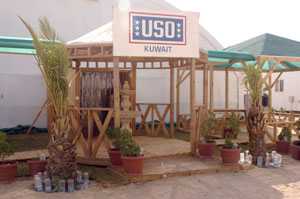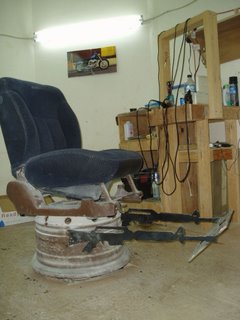
The Marine Corps is like a movie set. You've got your Producer (the Commanding General), the Director (the Deputy CG), the editor (the Chief of Staff), and your screen writers (the G-3 Operations staff). In the limelight, you've got your movie stars, the actors and actresses whom we watch on the big screen. In the Corps, your movie star is the 0311 Infantry Marine. Your basic grunt. He's the guy in the field, carrying out the actions and heroics that make the Marine Corps famous. He's the guy whom everyone else in the Corps is paid to support. He's the guy we think of when we hear the title "Marine."
Behind every successful director and movie star, there are a number of players that ensure the successful production of the film. You've got stuntmen and gaffers, key grips, wardrobe personnel and a host of other positions. Just like Hollywood, the Marine Corps has its own production crew, a bevvy of Marines who work behind the scenes to support their "cast" to ensure a succsseful operation. I've met a few of the Corps "production crew," the men and women who'll never be the stars, but will always be the backbone of the Corps, the reason for our success.

There’s US Navy Petty Officer (MR1) James Heard,a Machinery Repairman deployed with the 133rd Naval Mobile Construction Battalion (aka: the “Seabees”). Machinery Repairmen are skilled machine tool operators. They traditionally make replacement parts, repair or overhaul ship's engines and auxiliary systems, and work on deck equipment including winches and hoists, condensers and heat exchange devices. Miles from the ocean, MR1 Heard finds himself “working steel,” using his skills to design and craft specialty parts to sustain operations aboard the camp. He’s machined items ranging from custom water hose couplings for the Camp Fallujah Fire Department to replacement refrigeration parts for the dining facility. He’s produced bolt-on vehicle armor to protect our HMMWV convoy vehicles and has hastily manufactured specialty parts to repair inoperable M-240G machine guns. With only a lathe, drill press and grinder, he quickly turns scrap of metal into a functional object. He is the Picasso of steel.

Commander Stephen Christopher is also a repairman of sorts – he spends his days fixing broken fillings and cracked teeth of Marines and sailors deployed to OIF. He’s also spent time with soldiers of the Iraqi Army, providing emergency treatment to those in dire need of dental care. As the 2nd Marine Division Dental Officer, he has personally treated over 1100 patients during his deployment. A wanderer of sorts, I met CDR. Christopher at Hurricane Point in Ramadi, home of the 3rd Battalion, 7th Marines. He and his dental technician travel lightly, carrying a fold-up dental chair and dental tools in addition to their M-16’s and body armor. Despite the lack of a permanent office and the specialty tools associated with CONUS dentistry, he performs magic with cracked teeth, extractions, fillings and temporary crowns, a task made more difficult in the hostile environment of Iraq.

Major Mark Gilday, the II MEF (Fwd) G-4 Motor Transport Officer, was intimately involved with the introduction and installation of Marine Armor Kits (MAK) and Marine Armor Systems (MAS) on hundreds of II MEF (Fwd) HMMWV’s and 7-ton trucks. If you recall, Secretary Donald Rumsfeld was asked by an Army soldier in December, 2004, "Why do we soldiers have to dig through local landfills for pieces of scrap metal and compromised ballistic glass to up-armor our vehicles?" The Secretary’s initial response was testy. "You go to war with the army you have," he barked. The soldier’s question, it turned out, had been planted by a reporter embedded with the US Army 278th Regimental Combat Team. The effects of the question, however, resulted in a firestorm of activity for the Army and the Marine Corps over the next 12 months. Since deploying to Camp Fallujah, Major Gilday has coordinated the up-armoring of nearly 1200 of the II MEF’s HMMWV’s with the new MAK systems. These improvements have greatly increased the survivability of our Marines in the field.

Lance Corporal Stephanie Twichell, a Marine Corps reservist from New Orleans, LA, enlisted in the Corps in June, 2004. She’s spent her deployment guarding prisoners and suspected insurgents at the Regional Detention Facility (RDF) in Camp Fallujah. She performs a thankless job made even less enviable following the US Army debacle at Abu Ghraib prison in 2004. However, you’ll rarely find a Marine complain about this important duty, knowing they are the thin blue line that separates the residents of Camp Fallujah from the captured insurgents. Breaking the monotony of daily prisoner counts, feedings, and searches, she spends her off-duty hours learning new law enforcement techniques, such as TASER training, escalation of force and riot control. The challenges of deployment were doubled when Hurricane Katrina ravaged her hometown. Regardless, LCpl. Twichell continues to serve her country and her Corps with dignity and without a complaint.

In Al Qaim, Iraq, I ran into Captain Timothy Evans, Company Commander for Food Service Company, H&S Battalion, II Marine Logistics Group, formerly known as the FSSG. Captain Evans enlisted in the Corps in 1983 and is currently a limited duty officer, deployed to Iraq to supervise the fielding of the new Field Food Service System (FFSS), a mobile kitchen unit which will update the old Marine Corps “mess kitchens,” taking us away from 1950’s technology and into the 21st century of food preparation. Captain Evans supervised the installation of these portable kitchen units at FIRM bases and FOB’s along the Syrian border, the unit itself enclosed within two 20’ x 8’ self-sufficient ISO containers similar to those seen stacked aboard transatlantic freighters. In lieu of eating MRE’s and pogey bait, the grunts on the front lines can now enjoy freshly prepared hot chow from these portable kitchens, capable of operating in black-out environments, all the while providing the field messmen protection from indirect and small arms fire. Nothing motivates a dirty, tired, and worn-out troop better than hot chow.

Others, like Colonel Gary Wilson, a retired Marine
brought back on active duty to serve as the II MEF (Fwd) Anti-Terrorism/Force Protection Officer (ATFP), conduct their daily duties atypical to that of their fellow Marines. The Colonel and his small staff play the part of the devils advocate, intentionally thinking and acting like the bad guy. They develop “red cell” ideas and schemes on how to successfully attack the base and threaten the safety of our Marines. He and his team conduct surveys of the camp perimeter in search of vulnerabilities and weaknesses, an attempt to uncover weaknesses in a units force protection stance. Afterward, he suggests methods to correct the vulnerabilities and improve the levels of protection for Marines deployed in theater. His findings are sometimes rebuffed by Commanders unwilling to believe they are less than prefect, that their individual force protection plans may have missed something upon implementation. Regardless, the Colonel and his staff are the mechanism that identifies and helps bring in the necessary technology and equipment to further enhance the safety of our Marines, be they in Camp, at a checkpoint, or in a vehicle.

Similar to the my job as the Marine Corps Field Historian, Sgt. Josh Hauser spends his deployment collecting stories from Marines far and wide. Sgt. Hauser is a combat correspondent with the II MEF Headquarters Group (MHG), traveling from FOB to FOB, embedding with Marines from various companies and platoons in search of the stories that will tell the world the tale of the Marine Corps in OIF. Unlike my Field History collection, Sgt. Hauser’s stories are published in hometown newspapers, spreading the exploits of our young Marines at work and play in Iraq. He’s a gypsy among Marines, attempting to live the story of which he writes, if only for a short period of time. His weapons are his camera and pen, although he has often put them aside to shoulder his weapon to protect himself and his temporary family. He goal as a combat correspondent is to balance the negative image of the Marine Corps as portrayed in mainstream media with good news stories from our Marines, fighting the good fight, doing what needs to be done to protect the freedoms of the naysayers back home.
 On February 15th, we left our temporary home at Camp Victory and traveled via bus to the Kuwait International Airport, the next stop in our journey eastward. After boarding a charter jet at the Kuwait City International Airport, we departed for Shannon, Ireland, our one and only layover between Kuwait and Cherry Point, North Carolina. Our brief stop in Shannon gave us the opportunity to debark the plane and stretch our legs inside the international terminal. Most of the Marines headed straight for the bar to purchase their first beer since arriving in Iraq. The Marines were given a 2 beer limit, primarily to avoid any alcohol related incidents on our way home. At 6:30 in the morning, however, I was in no mood for a beer and opted for a double-shot of espresso instead. Several Marines opted to spend their time browsing the duty free shops in search of some last minute trinkets for kids, spouses and significant others.
On February 15th, we left our temporary home at Camp Victory and traveled via bus to the Kuwait International Airport, the next stop in our journey eastward. After boarding a charter jet at the Kuwait City International Airport, we departed for Shannon, Ireland, our one and only layover between Kuwait and Cherry Point, North Carolina. Our brief stop in Shannon gave us the opportunity to debark the plane and stretch our legs inside the international terminal. Most of the Marines headed straight for the bar to purchase their first beer since arriving in Iraq. The Marines were given a 2 beer limit, primarily to avoid any alcohol related incidents on our way home. At 6:30 in the morning, however, I was in no mood for a beer and opted for a double-shot of espresso instead. Several Marines opted to spend their time browsing the duty free shops in search of some last minute trinkets for kids, spouses and significant others.  Nearly 15 hours after leaving Kuwait, the plane touched down at Marine Corps Air Station, Cherry Point, NC. The date was February 15th, 2006, the sun shining brightly as we taxied down the runway and eased into the terminal area. The Marines were all smiles as the doors opened and we caught our first breath of fresh Carolina air. Gone were the pungent odors of burning trash and port-o-johns. We had finally arrived home.
Nearly 15 hours after leaving Kuwait, the plane touched down at Marine Corps Air Station, Cherry Point, NC. The date was February 15th, 2006, the sun shining brightly as we taxied down the runway and eased into the terminal area. The Marines were all smiles as the doors opened and we caught our first breath of fresh Carolina air. Gone were the pungent odors of burning trash and port-o-johns. We had finally arrived home.










